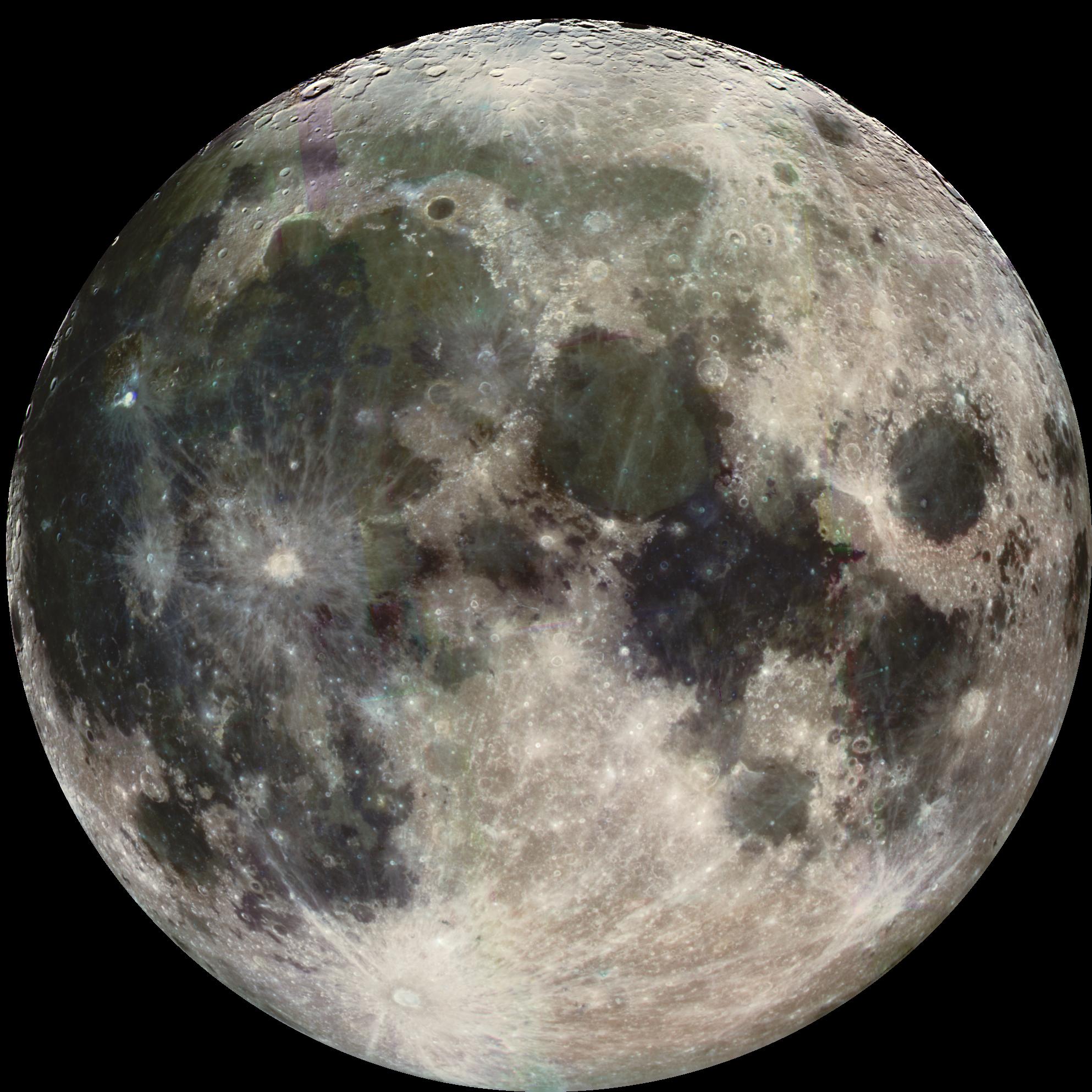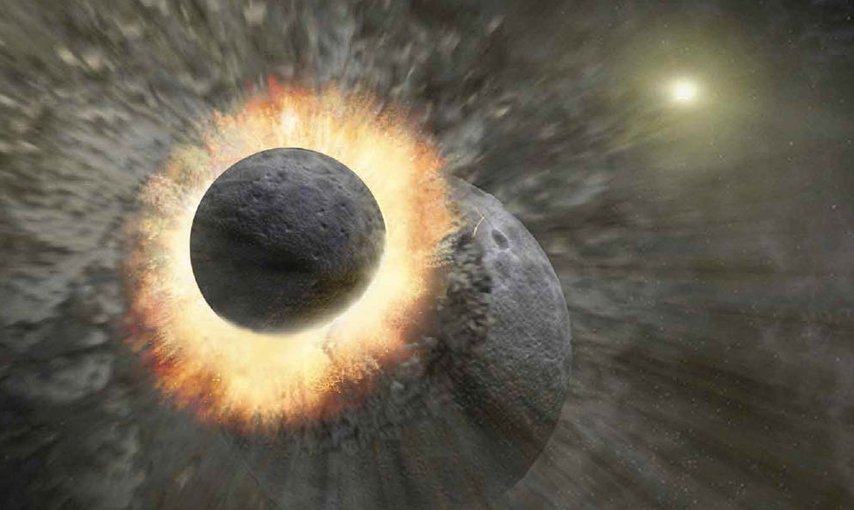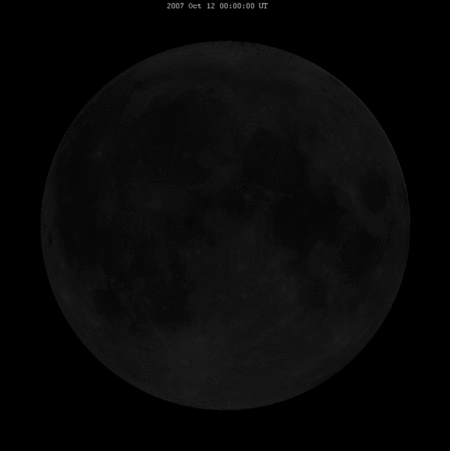
M. Wasser, NASA Solar System Exploration (2018).
Aidan Caldwell-Jones, Bryn Grenier, Haylee Woytkiw, Kenzie Duke, Venkata Manikanta Dodla
Understanding the Moon’s creation and past will, in turn, help us learn about the Earth’s history. Information about the Moon gives us knowledge and a more precise understanding of ourselves and how we began. If the Moon is debris from Earth, then the similarities between us are possibly substantial enough to learn new information about Earth. With the knowledge on how Earth’s Moon formed, we are also able to hopefully have a greater understanding of other planets’ moons, how they were created, thus giving us a better and more in-depth knowledge of the universe as a whole. Throughout history, there have been multiple theories on how the Moon formed. There is an extensive history behind the theories of how the Moon was formed, including capture theory, fission theory, and the giant-impact theory. At this moment in time, we find that the giant-impact is the most accepted and well-researched theory. We wish to answer how the Earth’s Moon was formed.

Commons.Wikimedia.Org (2018).
History
George Darwin
We need to understand the evolution of ideas and evidence for why past astronomers thought the way they did, and how these discoveries affect the way we think now. Studying history is an essential way to understand the present, and for science, we can build off of past ideas. George Darwin was a prominent figure in astronomy and especially in the origin of the Moon. Darwin was born on July 19, 1845, in Kent, England [3]. Much of his work focused on tides and the Moon. His theory on the formation of the Moon was that solar waves pulled away matter from Earth while it was still covered in molten [3]. While this theory is no longer accepted, it made future astronomers think that the Moon might at one point have been part of the Earth, and thus Darwin championed this idea [3]. With this knowledge from Darwin, we have the giant-impact theory, which is highly accepted.
Ernst Opik
Another prominent figure in the origin of the Moon is astronomer Ernst Opik. Opik was born on October 23, 1893, in Estonia, Russia [4]. He mainly studied meteors and meteorites, dedicating his life to understanding the cosmos structure and evolution [4]. Opik’s contribution to theories about the Moon’s origin is that he believed the Moon formed by a terrestrial sediment ring compacting [5].
Theories on the Formation of the Moon
Capture Theory
The capture theory is one of the three theories explored in determining how the Moon formed. It examines the idea of the Moon being formed somewhere else in the solar system, apart from Earth. After being formed apart from Earth, it was then later captured in the gravitational field of the planet [4]. The theory was developed and examined throughout time by many scientists. The scientist who studied the theory determined that other approaches throughout the formation of the Moon seemed to be supported more than the capture theory.
Although the capture theory helped discover how the Moon formed, the Apollo missions determined that if the Moon had been created in another location and was captured by the Earth’s gravity, the composition would be different from the Earth’s [6]. The discoveries made during Apollo missions allowed individuals to recognize that the capture theory did not fit into the discovery of the Moon and how it formed. The composition of the Moon would not align with how the capture theory determined the formation of the Moon. The composition of the Moon was determined to be less dense than the Earth. Scientists who worked on the theories discovered that the capture theory was not as informed as other theories.
Along with the composition of the Moon, the capture theory also addresses evidence among orbiters. Orbiters within the capture theory were also noted to have a different shape than the Moon. The Moon is a spherical body, while orbiters are often oddly shaped. The paths of orbiters also don’t tend to line up with the ecliptic of their parent plant, which is another feature that differs from the Moon [7].
The information gathered by scientists concluded that the capture theory was not accurate in determining how the Moon formed. Although the capture theory was not valid, it did help determine how the Moon was formed by ruling out the hypothesis within the theory.
Fission Theory
The fission hypothesis states that the Moon separated from Earth. George Darwin (the son of Charles Darwin) proposed fission theory in the late nineteenth century. Being a British mathematician and astronomer, he worked to propose this theory but did not receive much attention from it. George Darwin’s theory that the Moon formed while the Earth was quickly spinning when it was still molten would have caused a part of Earth to fly off into space [8]. Fission theory suggests that the Moon formed at the same time as the Earth. Not through accretion but by a spinning Earth ejecting a giant blob of material into space, which then developed into the shape and orbit of the Moon. If this did occur, the Moon would have separated off from the Pacific Ocean Basin region. Darwin supposed this theory to be correct because the Moon is continuously moving farther away from the Earth [8].
Calculations in modern times have shown that this ‘spontaneous’ fission is impossible. Furthermore, the present-day Earth/Moon system should contain a geological record of Earth’s surface because of this rapid spin, which it does not. Although this theory explains the composition similarities between the Moon and the Earth, this is not widely accepted as evidence. It is difficult to understand how a Moon composed of terrestrial material could have developed many distinctive chemical differences. The reason for this is angular momentum, which proposes that Earth today is too small for this to have occurred. It would not have been possible for part of the Earth to ‘escape’ into space. To conclude, despite fission theory holding value in that it explains many of the connections between the Moon and the Earth’s mantle today, there are significant downfalls and consequently must be treated with consideration [9].
Giant-Impact Theory
The giant-impact theory is the most prominent and widely accepted explanation for the Moon’s formation. It explains the geo-chemistry and mechanics of the angular momentum of the Earth-Moon system, by carefully iterating through a series of scientific methods, observation, and experimentation. The theory states that after the formation of the Solar System, an astronomical object named Theia, about the same size as Mars, collided with the partially formed proto-Earth [10]. This catastrophic event melted the outer layers of Earth and the astronomical body, ejecting the material into the Earth’s orbit, coalescing the now-known Moon [10].
A considerable number of scientists and theories tried to falsify the giant-impact theory like one argument pointed out there were “distinct Oxygen isotopic signatures” amongst the astronomical bodies [11]. However, recent research proved that the Earth and Moon have identical oxygen isotopic ratios, and early astronomers hypothesized that a significant portion of the Moon’s core is made up of the remains of Theia. Scientists gathered four pieces of evidence that boosted the applicability of the giant-impact theory over capture and fission theory: [a] Earth-Moon system angular momentum [b] melted geology of the Moon [c] No lunar core [d] late Moon formation, which put an end to the conundrum [12].

A. Gronstal, Astrobiology.Nasa.Gov (2017).
Evidence Supporting Giant-Impact Theory
1. Earth-Moon System Angular Momentum
Proving the angular momentum of the Earth-Moon system, played a crucial role in identifying the mass of Theia and in the success of the giant-impact theory. The present momentum of the Earth-Moon system was compared to the virgin proto-earth system, in which scientists concluded that the mass of the astronomical object, Theia, was the same as the planet Mars. If the Moon originated from Earth, then the present angular momentum should be consistent with the early Earth-Moon angular momentum system. However, the results from various simulations contradicted the theory [12]. The present angular momentum was smaller than the early momentum, and this problem raised concerns regarding the validity of the giant-impact theory. Scientists theorized that, after the impact of the two heavenly bodies, a tremendous amount of mass from both the bodies was ejected into space; hence the present angular momentum was inconsistent with the early angular momentum [12].
2. Melted Geology of the Moon
The surface of the Moon is covered in thousands of craters ranging from 10 to 100 kilometres in length. Scientists believe that these craters formed from meteorites and asteroids colliding with the Moon. Research suggests that these collisions began around 3.9 billion years ago and lasted nearly 100 million years. When meteorites strike the Moon at high speed, the meteorites and surface rock from the Moon partially melt and form into glass. Lunar rocks that were brought back from the Apollo missions revealed that some of the rocks displayed signs of melting nearly 3.9 million years ago [13]. This information helps support the giant-impact theory because it is known by scientists that during the beginning of the solar system, there were many collisions between planets and other debris floating around outer space.
3. No Lunar Core
The details surrounding the lunar core was critical in determining the accurate model of the Moon’s formation. The lunar core between the Moon and Earth are determined to differ. Although the lunar core varies between the two planets, the research suggests that the Moon has generated and maintained a strong magnetic field. The core differs from the Earth because it was found to have a partially molten boundary layer around the core. The research surrounding the lunar core, allows scientists to determine the giant-impact theory to be the most accurate in determining the formation of the Moon [14].
Late Moon Formation
The giant-impact theory is consistent with a late formation of the Moon, this correlates with an impact occurring near the end of Earth’s formation, what we know of Earth’s current elemental composition, and the angular momentum of the Earth-Moon system [15]. Currently, one of the best ways to date the Moon is the Sr isotopes and the depletion of Rb, which occurred at the formation [15]. This way of dating is consistent with the lack of losses of moderately volatile elements [15]. Using various simulations, we can tell that to create as close to the Earth-Moon system that exists today is that the impact must have occurred from an object with a mass approximately the size of mars that occurs near the end of Earth’s formation [14]. When comparing different formation theories, a late moon is only consistent with the giant impact theory.
In Conclusion…
During this project, we investigated the main theories that have been proposed over the years on the formation of the Moon and delved into how scientists came to accept the current theory. Scientists, including George Darwin, Ringwood, and Opik, have all been essential in the creation of the theories about how the Moon formed [1]. The three main theories include the capture theory, the fission theory, and the giant-impact theory [2]. Considering all the information we researched, we all agree that the giant-impact theory is the most accurate depiction of how the Moon formed. Considerable amounts of research, observations, and experiments were involved in the making of this theory. The four key pieces of evidence include the Earth-Moon angular momentum, the melted geology of the Moon, the late formation of the Moon, and the absence of a lunar core [12]. During the giant-impact theory, a large object called Theia, which is roughly the size of Mars, collided with early Earth and melted Earth’s outer layers. The debris from the collision then propelled back into the Earth’s orbit and created the Moon [10]. Many have tried to prove this theory wrong; however, this only resulted in more evidence supporting the giant-impact theory [12]. The substantial scientific evidence that backs up this theory is the most widely believed theory among scientists and the scientific community [7].

Tomruen, En.Wikipedia.Org (2007).
References
1 J.A. Okeefe, Astrophysics and Space Science 16, 201 (1972).
2 StarChild. Question of the Month for October 2001. https://starchild.gsfc.nasa.gov/docs/StarChild/questions/question38.html (Accessed 5 March 2020)
3 The Editors of Encyclopaedia Britannica. Sir George Darwin https://www.britannica.com/biography/George-Darwin (Accessed 5 March 2020)
4 The Editors of Encyclopaedia Britannica, Encyclopædia Britannica (2019). https://www.britannica.com/biography/Ernst-Julius-Opik
5 A. Ringwood, Earth and Planetary Science Letters 8, 131 (1970).
6 K. Lotozof, How Did the Moon Form. https://www.nhm.ac.uk/discover/how-did-the-moon-form.html (Accessed 17 March 2020)
7 N. Reed, How was the Moon Formed .https://www.space.com/19275-moon-formation.html (Accessed 17 March 2020)
8 S. Himson, Fission theory, https://howthemoonformed.weebly.com/fission-theory.html (Accessed 20 March 2020)
9 A. P. Boss, Science 231, 341 (1986)
10 Servi, NASA scientist Jen Heldmann describes how the Earth’s moon was formed https://sservi.nasa.gov/articles/nasa-scientist-jen-heldmann-describes-how-the-earths-moon-was-formed/ (Accessed 18 March 2020)
11 Staff Writers, Space Daily. (2012)
12 E. Asphaug, Annual Review of Earth and Planetary Sciences 42, 551 (2014).
13Astrobiology Magazine. Melting the moon https://www.astrobio.net/moon-to-mars/melting-the-moon/ (Accessed 29 March 2020)
14 A.N. Halliday, Philosophical Transactions of the Royal Society A: Mathematical, Physical and Engineering Sciences 366, 4163 (2008).
15 R.M. Canup and E. Asphaug, Nature 412, 708 (2001).
16 B. Dunbar. NASA Reserach Team Reveals moon Has Earth-Like Core https://www.nasa.gov/topics/moonmars/features/lunar_core.html (Accessed 25 March 2020)